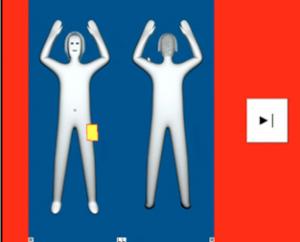Full body screening technology has been in operation at major Canadian airports for three years. Currently, 52 full-body scanners are in use in Canadian airports. Passengers selected for a secondary search can choose between the full body scanner or a physical search.
Process
The automatic target recognition software for full body scanners produces a computer generated "stick figure" that makes it possible to detect anomalies concealed under clothing. Passengers who choose a full body scan enter the scanner, stand with their feet apart and extend their arms over their head. The scan takes about five seconds. When the process is complete, passengers exit on the opposite side of the scanner.
Technology
The millimetre-wave technology works by projecting low-level radio frequency (RF) energy over and around the passenger's body. The RF wave is reflected back from the body and signals are recovered using highly sensitive detectors. The stick figure image is displayed on a screen and will identify areas of the body where objects may be concealed under clothing.
New Automatic Target Recognition software image
The technology detects "anomalies" on a passenger, including metals and non-metals of all types, sizes and shapes; ceramic-type threats such as knives and sharp instruments; liquids of all types; and explosives of all types.
Health and Safety
The millimetre-wave scanners do not pose a risk to human health and safety in either single or repeated exposures. Health Canada has reviewed the technical information on these devices and concluded that the radio frequency energy they emit is well within Canada's guidelines for safe human exposure. As a point of reference, the manufacturer indicates that the energy put out by the scanners is 1/10000th of the energy from a cell phone.
Privacy
With new ATR software, the full body scanner continues to detect anomalies and concealed objects on passengers. To continue to ensure that every passenger's privacy is fully respected, the scanner does not collect personal information from the passengers it screens. The Government of Canada worked with the Office of the Privacy Commissioner to ensure that privacy concerns were appropriately addressed.
April 2013
Related Items
April 16, 2013
News Release - Harper Government announces new software to enhance passenger privacy at airports
